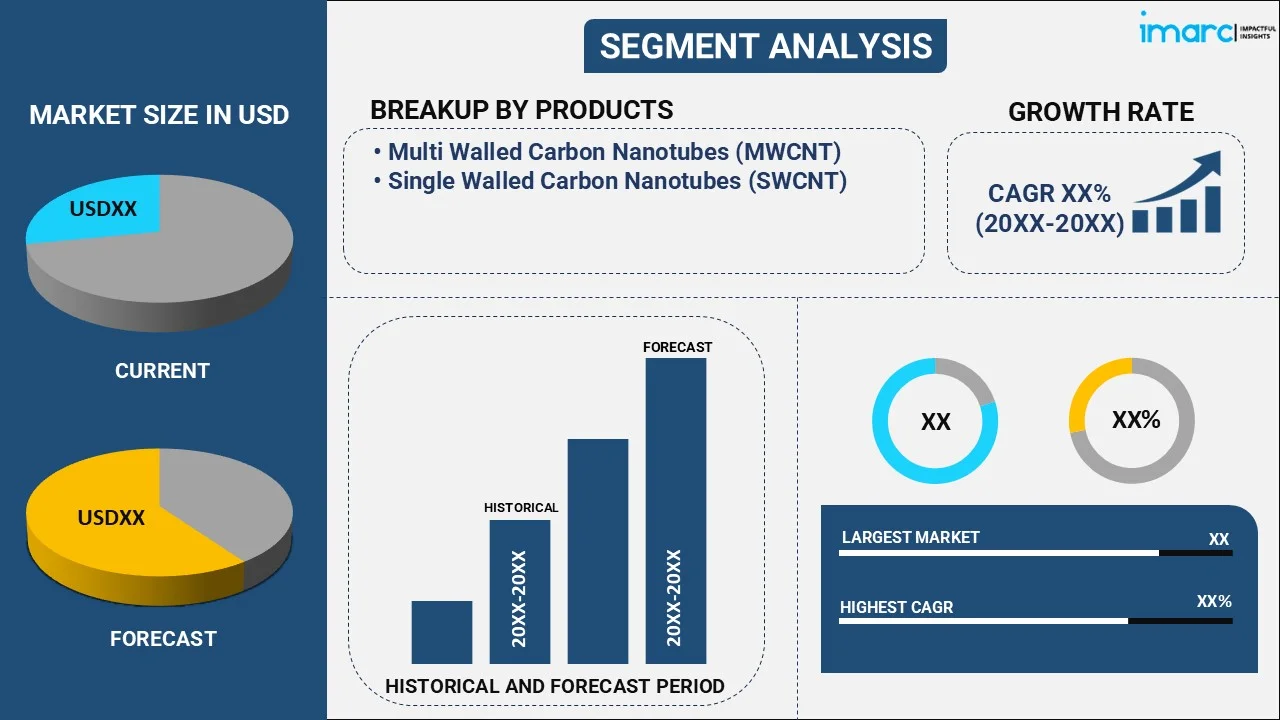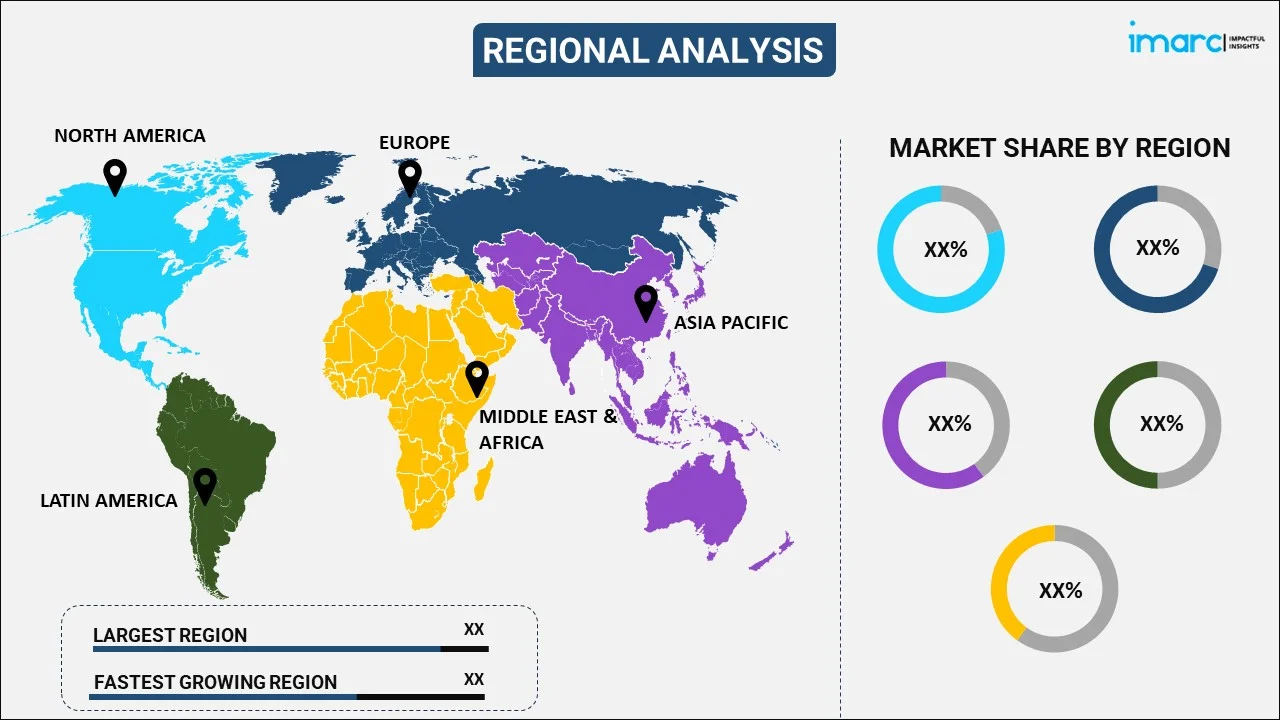
Carbon Nanotubes Market Report by Product (Multi Walled Carbon Nanotubes (MWCNT), Single Walled Carbon Nanotubes (SWCNT)), Method (Chemical Vapor Deposition (CVD), Catalytic Chemical Vapor Deposition (CCVD), High-Pressure Carbon Monoxide Reaction, and Others), Application (Polymers, Electrical and Electronics, Energy, and Others), and Region 2025-2033
Global Carbon Nanotubes Market:
The global carbon nanotubes market size reached USD 6.6 Billion in 2024. Looking forward, IMARC Group expects the market to reach USD 24.0 Billion by 2033, exhibiting a growth rate (CAGR) of 15.46% during 2025-2033. The increasing product demand for conductive additives in electronic devices, growing product applications in advanced materials for aerospace and automotive industries, and rising interest in sustainable nanomaterial solutions for energy storage and environmental remediation, are primarily driving the market growth.
|
Report Attribute
|
Key Statistics
|
|---|---|
|
Base Year
|
2024
|
|
Forecast Years
|
2025-2033
|
|
Historical Years
|
2019-2024
|
|
Market Size in 2024
|
USD 6.6 Billion |
|
Market Forecast in 2033
|
USD 24.0 Billion |
| Market Growth Rate 2025-2033 | 15.46% |
Carbon Nanotubes Market Analysis:
- Major Market Drivers: Significant growth in the aerospace industry and the widespread adoption of multi-walled carbon nanotubes for cathode-ray lighting elements and wafer processing are primarily driving the growth of the market.
- Key Market Trends: The increasing product demand for the production of drug delivery and biosensing systems that are utilized for the treatment of diseases and monitoring health is positively impacting the market growth.
- Competitive Landscape: Some of the leading carbon nanotubes market companies are Arkema S.A, Cabot Corporation, Carbon Solutions Inc., Cheap Tubes Inc., Jiangsu Cnano Technology Co. Ltd., Kumho Petrochemical Co. Ltd., LG Chem Ltd. (LG Corporation), Nanocyl SA, OCSiAl, Ossila Ltd., Raymor Industries Inc., and Showa Denko K.K., among others.
- Geographical Trends: According to the report, Asia-Pacific currently dominates the global market. China is the largest producer and consumer of carbon nanomaterials in Asia-Pacific. The abundance of available raw materials and the low cost of production supported the growth of the carbon nanomaterials market in the country. Moreover, the extensive application of CNT in expanding the electronics industry in the region is creating a positive outlook for the overall market.
- Challenges and Opportunities: The carbon nanotubes market faces challenges such as high production costs, scalability issues, and concerns regarding environmental and health impacts. However, opportunities abound with ongoing research advancements, expanding applications in diverse industries, and increasing demand for lightweight, high-performance materials in areas like electronics, aerospace, and energy storage.

Carbon Nanotubes Market Trends:
Increasing Product Application in Automotives and Electronics
Carbon nanotubes (CNTs) are finding extensive use in automotive applications due to their exceptional mechanical properties, lightweight nature, and electrical conductivity. Moreover, the escalating demand for lightweight vehicles is also catalyzing the market for CNTs. Carbon nanotubes can be incorporated into composites used for vehicle parts such as body panels, chassis components, and interior parts, reducing overall weight while maintaining strength and durability. For instance, in August 2023, a research team led by Clemson University, in collaboration with NETL and with support from Honda, developed a lightweight vehicle door using carbon fiber, thermoplastic resin, and advanced computer design. This door is 32% lighter than a conventional steel door and successfully meets federal safety standards and Honda's specific safety requirements. Besides this, carbon nanotubes (CNTs) are extensively being utilized in electronics for creating conductive films used in touchscreens, flexible displays, and printed electronics due to their excellent electrical conductivity and transparency. Additionally, the rising demand for electronic gadgets, such as smartphones, televisions, laptops, tablets, etc., is also propelling the carbon nanotubes market share. For instance, in 2024, the revenue generated in the consumer electronics market worldwide amounted to a staggering US$ 1,046.0 Billion.
Growing Product Demand in the Energy Sector
Carbon nanotubes (CNTs) are gaining much attention as catalyst support for energy applications, primarily solar cells, fuel cell catalysts, and hydrogen storage, owing to their high surface area and conductivity. In line with this, various countries are increasingly investing in renewable power technologies to expand renewable power capacities, which is positively impacting the carbon nanotubes market outlook. For instance, China is planning to install almost half of the new global renewable power capacity over 2022–2027, despite the phase-out of wind and solar PV subsidies. Moreover, China’s ambitious renewable energy targets in the 14th Five-Year Plan, market reforms, and solid provincial government support provide long-term revenue certainty for renewables. Similarly, the pace of renewable capacity expansion in Europe is expected to be double during 2022–2027. In the United States, the IRA was passed in August 2022 and extended tax credits for renewables until 2032, providing unprecedented long-term visibility for wind and solar PV projects. In India, new installations are also set to double. This is led by solar PV and driven by competitive auctions implemented to achieve the government’s ambitious target of 500 GW of renewable power by 2030. The increasing focus on integrating sustainable and renewable energy is anticipated to propel the carbon nanotubes market revenue in the coming years.
Expanding Aerospace Industry
CNT-based materials are highly effective at shielding against electromagnetic interference (EMI), which is crucial for protecting sensitive electronic systems onboard aircraft from external electromagnetic radiation. In addition to this, CNTs can reinforce composite materials used in aerospace applications, enhancing their mechanical properties such as stiffness, strength, and durability while maintaining a low-weight profile. Furthermore, the expanding aerospace industry and the increasing number of aerospace facilities across the globe are also augmenting carbon nanotubes market demand. For instance, in March 2024, Israel Aerospace Industries (IAI) announced that they would be establishing a new aerospace defense company in India, named Aerospace Service India (ASI). IAI said the establishment of ASI demonstrated new levels of collaboration between the group and the Indian government’s plans to promote national independence. Moreover, the government authorities of various nations are taking initiatives and providing funds to bolster defense capabilities, which is further bolstering the market growth. For instance, in March 2024, the Indian government launched the Acing Development of Innovative Technologies with iDEX (ADITI) scheme. This scheme aims to promote innovation in critical and strategic defense technologies by providing grants of up to Rs 25 crore to eligible start-ups for research, development, and innovation endeavors in defense technology.
Global Carbon Nanotubes Market Segmentation:
IMARC Group provides an analysis of the key trends in each segment of the global carbon nanotubes market report, along with forecasts at the global, regional, and country levels from 2025-2033. Our report has categorized the market based on product, method, and application.
Breakup by Product:

- Multi Walled Carbon Nanotubes (MWCNT)
- Single Walled Carbon Nanotubes (SWCNT)
Multi Walled Carbon Nanotubes (MWCNT) holds the majority of the total market share
The report has provided a detailed breakup and analysis of the market based on product. This includes Multi Walled Carbon Nanotubes (MWCNT) and Single Walled Carbon Nanotubes (SWCNT). According to the carbon nanotubes market research report, Multi Walled Carbon Nanotubes (MWCNT) holds the majority of the total market share.
Multi-walled carbon nanotubes (MWCNTs) consist of several concentric layers of graphene rolled up to form a tube-like structure. Their unique architecture imparts exceptional mechanical strength, electrical conductivity, and thermal properties. MWCNTs find diverse applications in fields such as aerospace, electronics, materials science, and biotechnology due to their versatility and performance characteristics. Moreover, carbon nanotubes market statistics by IMARC indicate that the expanding automotive, electronics, and aerospace industries are bolstering the market for multi-walled carbon nanotubes. For instance, in January 2023, MG Motor India announced a US$ 100 Million investment to expand capacity. Similarly, in December 2022, Mahindra & Mahindra revealed plans to invest INR 10,000 crore (US$ 1.2 Billion) in an EV manufacturing plant in Pune, India. This investment emphasizes the growing significance of the EV sector. Furthermore, compared to single-walled carbon nanotubes (SWCNTs), MWCNTs often exhibit higher tensile strength and thermal stability, making them suitable for demanding applications requiring robust materials. Their multi-layered structure allows for tailored properties and functionality, offering versatility in engineering novel nanomaterial-based solutions. As a result, their increasing adoption is anticipated to propel the carbon nanotubes market’s recent price in the coming years.
Breakup by Method:
- Chemical Vapor Deposition (CVD)
- Catalytic Chemical Vapor Deposition (CCVD)
- High-Pressure Carbon Monoxide Reaction
- Others
Chemical Vapor Deposition (CVD) method currently exhibits a clear dominance in the market
The report has provided a detailed breakup and analysis of the market based on method. This includes Chemical Vapor Deposition (CVD), Catalytic Chemical Vapor Deposition (CCVD), high-pressure carbon monoxide reaction, and others. According to the carbon nanotubes market report, Chemical Vapor Deposition (CVD) method currently exhibits a clear dominance in the market.
Chemical Vapor Deposition (CVD) is a method used to synthesize carbon nanotubes (CNTs) by introducing carbon-containing gases into a reaction chamber at high temperatures. The gases decompose, and carbon atoms precipitate onto a substrate, forming nanotubes. CVD offers control over CNT characteristics such as diameter, length, and alignment, making it a versatile and widely used technique in nanomaterials synthesis.
Breakup by Application:
- Polymers
- Electrical and Electronics
- Energy
- Others
Polymers account for the largest market share
The report has provided a detailed breakup and analysis of the market based on application. This includes polymers, electrical and electronics, energy, and others. According to the report, polymers account for the largest market share.
Carbon nanotubes (CNTs) are utilized in polymers to enhance their mechanical, electrical, and thermal properties. They act as reinforcing agents, improving the strength, stiffness, and toughness of polymer composites. Additionally, CNTs can impart electrical conductivity to polymers, enabling the development of conductive plastics for applications such as flexible electronics and electromagnetic interference shielding. Their high thermal conductivity makes them suitable for enhancing the thermal properties of polymers in applications like heat dissipation materials and flame retardants.
Breakup by Region:

- North America
- United States
- Canada
- Asia-Pacific
- China
- Japan
- India
- South Korea
- Australia
- Indonesia
- Others
- Europe
- Germany
- France
- United Kingdom
- Italy
- Spain
- Russia
- Others
- Latin America
- Brazil
- Mexico
- Others
- Middle East and Africa
Asia-Pacific currently dominates the global market
The report has also provided a comprehensive analysis of all the major regional markets, which include North America (the United States and Canada); Asia Pacific (China, Japan, India, South Korea, Australia, Indonesia, and others); Europe (Germany, France, the United Kingdom, Italy, Spain, Russia, and others); Latin America (Brazil, Mexico, and others); and the Middle East and Africa. According to the report, Asia-Pacific currently dominates the global market.
The carbon nanotubes market overview by IMARC indicates that China is the largest producer and consumer of carbon nanomaterials in Asia-Pacific. The abundance of available raw materials and the low cost of production supported the growth of the carbon nanomaterials market in the country. Moreover, the extensive application of CNT in expanding the electronics industry across APAC countries like China and India is creating a positive outlook for the overall market. For instance, the Indian government is talking with prominent semiconductor companies to set up local manufacturing units. The government invited new applications for setting up Semiconductor Fabs and Display Fabs in India from June 2023 under the Modified Semicon India Programme with an outlay of INR 76,000 crore. Similarly, according to a report by the Japan Automobile Manufacturers Association (JAMA), the country produced 7,427,179 units of passenger cars and 1,286,414 units of trucks in 2022. All these factors are anticipated to positively impact the CNT market over the coming years.
Competitive Landscape:
The market research report has provided a comprehensive analysis of the competitive landscape. Detailed profiles of all major companies have also been provided. Some of the key players in the market include:
- Arkema S.A
- Cabot Corporation
- Carbon Solutions Inc.
- Cheap Tubes Inc.
- Jiangsu Cnano Technology Co. Ltd.
- Kumho Petrochemical Co. Ltd.
- LG Chem Ltd. (LG Corporation)
- Nanocyl SA
- OCSiAl
- Ossila Ltd.
- Raymor Industries Inc.
- Showa Denko K.K.
(Please note that this is only a partial list of the key players, and the complete list is provided in the report.)
Carbon Nanotubes Market Recent Developments:
- March 2024: A research team at the University of Pittsburgh developed a portable sensor that relies on carbon nanotubes and gold nanoparticles to detect even small amounts of fentanyl. This sensor also tells the difference between fentanyl and other opioids.
- February 2024: Researchers at Japan’s Osaka University unveiled a flexible, ultrathin optical sensor that uses carbon nanotubes to convert light into electrical signals. The team says that the device could lead to better optical imaging technologies.
- November 2023: Rice University was granted US$ 4.1 Million as a part of the journey towards sustainable materials research, to enhance carbon nanotube (CNT) synthesis, a critical component in the transition to green energy. This collaboration, jointly funded by The Kavli Foundation and Rice’s Carbon Hub, aims to provide sustainable alternatives to materials heavily reliant on traditional industry.
Global Carbon Nanotubes Market Report Scope:
| Report Features | Details |
|---|---|
| Base Year of the Analysis | 2024 |
| Historical Period | 2019-2024 |
| Forecast Period | 2025-2033 |
| Units | Billion USD |
| Scope of the Report | Exploration of Historical Trends and Market Outlook, Industry Catalysts and Challenges, Segment-Wise Historical and Predictive Market Assessment:
|
| Products Covered | Multi Walled Carbon Nanotubes (MWCNT), Single Walled Carbon Nanotubes (SWCNT) |
| Methods Covered | Chemical Vapor Deposition (CVD), Catalytic Chemical Vapor Deposition (CCVD), High-Pressure Carbon Monoxide Reaction, Others |
| Applications Covered | Polymers, Electrical and Electronics, Energy, Others |
| Regions Covered | Asia Pacific, Europe, North America, Latin America, Middle East and Africa |
| Countries Covered | United States, Canada, Germany, France, United Kingdom, Italy, Spain, Russia, China, Japan, India, South Korea, Australia, Indonesia, Brazil, Mexico |
| Companies Covered | Arkema S.A, Cabot Corporation, Carbon Solutions Inc., Cheap Tubes Inc., Jiangsu Cnano Technology Co. Ltd., Kumho Petrochemical Co. Ltd., LG Chem Ltd. (LG Corporation), Nanocyl SA, OCSiAl, Ossila Ltd., Raymor Industries Inc., Showa Denko K.K, etc. |
| Customization Scope | 10% Free Customization |
| Post-Sale Analyst Support | 10-12 Weeks |
| Delivery Format | PDF and Excel through Email (We can also provide the editable version of the report in PPT/Word format on special request) |
Key Benefits for Stakeholders:
- IMARC’s report offers a comprehensive quantitative analysis of various market segments, historical and current market trends, market forecasts, and dynamics of the carbon nanotubes market from 2019-2033.
- The research study provides the latest information on the market drivers, challenges, and opportunities in the global carbon nanotubes market.
- The study maps the leading, as well as the fastest-growing, regional markets. It further enables stakeholders to identify the key country-level markets within each region.
- Porter's five forces analysis assist stakeholders in assessing the impact of new entrants, competitive rivalry, supplier power, buyer power, and the threat of substitution. It helps stakeholders to analyze the level of competition within the carbon nanotubes industry and its attractiveness.
- Competitive landscape allows stakeholders to understand their competitive environment and provides an insight into the current positions of key players in the market.
Key Questions Answered in This Report
The global carbon nanotubes market was valued at USD 6.6 Billion in 2024.
We expect the global carbon nanotubes market to exhibit a CAGR of 15.46% during 2025-2033.
The widespread utilization of carbon nanotubes in manufacturing sporting goods, thin-film electronics, electromagnetic shields, water filters, etc., owing to their lightweight, highly flexible, and controlled temperature resistance properties, and the increasing utilization of carbon nanotubes in manufacturing lightweight automobiles are some of the carbon nanotubes market recent opportunities, bolstering the growth of the market.
The sudden outbreak of the COVID-19 pandemic had led to the implementation of stringent lockdown regulations across several nations resulting in temporary closure of numerous end-use industries for carbon nanotubes.
Based on the product, the global carbon nanotubes market can be segmented into Multi Walled Carbon Nanotubes (MWCNT) and Single Walled Carbon Nanotubes (SWCNT). Currently, Multi Walled Carbon Nanotubes (MWCNT) holds the majority of the total market share.
Based on the method, the global carbon nanotubes market has been divided into Chemical Vapor Deposition (CVD), Catalytic Chemical Vapor Deposition (CCVD), high-pressure carbon monoxide reaction, and others. Among these, Chemical Vapor Deposition (CVD) method currently exhibits a clear dominance in the market.
Based on the application, the global carbon nanotubes market can be categorized into polymers, electrical and electronics, energy, and others. Currently, polymers account for the largest market share.
On a regional level, the market has been classified into North America, Asia-Pacific, Europe, Latin America, and Middle East and Africa, where Asia-Pacific currently dominates the global market.
Some of the major players in the global carbon nanotubes market include Arkema S.A, Cabot Corporation, Carbon Solutions Inc., Cheap Tubes Inc., Jiangsu Cnano Technology Co. Ltd., Kumho Petrochemical Co. Ltd., LG Chem Ltd. (LG Corporation), Nanocyl SA, OCSiAl, Ossila Ltd., Raymor Industries Inc., and Showa Denko K.K., among others.
Need more help?
- Speak to our experienced analysts for insights on the current market scenarios.
- Include additional segments and countries to customize the report as per your requirement.
- Gain an unparalleled competitive advantage in your domain by understanding how to utilize the report and positively impacting your operations and revenue.
- For further assistance, please connect with our analysts.
 Inquire Before Buying
Inquire Before Buying
 Speak to an Analyst
Speak to an Analyst
 Request Brochure
Request Brochure
 Request Customization
Request Customization




.webp)




.webp)












